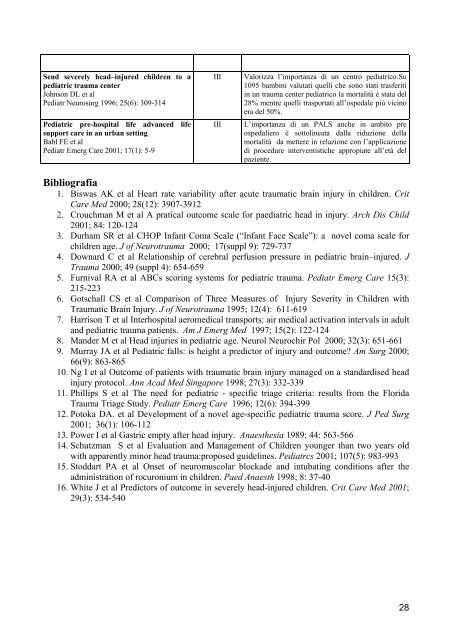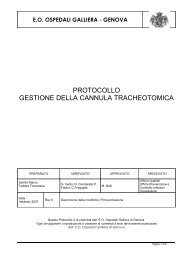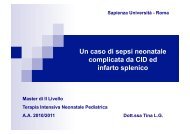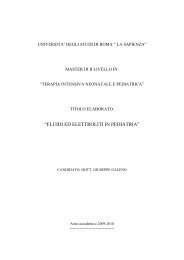Linee guida trauma cranico pediatrico grave SIAARTI-SARNEPI
Linee guida trauma cranico pediatrico grave SIAARTI-SARNEPI
Linee guida trauma cranico pediatrico grave SIAARTI-SARNEPI
You also want an ePaper? Increase the reach of your titles
YUMPU automatically turns print PDFs into web optimized ePapers that Google loves.
Send severely head–injured children to a<br />
pediatric <strong>trauma</strong> center<br />
Johnson DL et al<br />
Pediatr Neurosurg 1996; 25(6): 309-314<br />
Pediatric pre-hospital life advanced life<br />
support care in an urban setting<br />
Babl FE et al<br />
Pediatr Emerg Care 2001; 17(1): 5-9<br />
III Valorizza l’importanza di un centro <strong>pediatrico</strong>.Su<br />
1095 bambini valutati quelli che sono stati trasferiti<br />
in un <strong>trauma</strong> center <strong>pediatrico</strong> la mortalità è stata del<br />
28% mentre quelli trasportati all’ospedale più vicino<br />
era del 50%.<br />
III L’importanza di un PALS anche in ambito pre<br />
ospedaliero è sottolineata dalla riduzione della<br />
mortalità da mettere in relazione con l’applicazione<br />
di procedure interventistiche appropiate all’età del<br />
paziente.<br />
Bibliografia<br />
1. Biswas AK et al Heart rate variability after acute <strong>trauma</strong>tic brain injury in children. Crit<br />
Care Med 2000; 28(12): 3907-3912<br />
2. Crouchman M et al A pratical outcome scale for paediatric head in injury. Arch Dis Child<br />
2001; 84: 120-124<br />
3. Durham SR et al CHOP Infant Coma Scale (“Infant Face Scale”): a novel coma scale for<br />
children age. J of Neuro<strong>trauma</strong> 2000; 17(suppl 9): 729-737<br />
4. Downard C et al Relationship of cerebral perfusion pressure in pediatric brain–injured. J<br />
Trauma 2000; 49 (suppl 4): 654-659<br />
5. Furnival RA et al ABCs scoring systems for pediatric <strong>trauma</strong>. Pediatr Emerg Care 15(3):<br />
215-223<br />
6. Gotschall CS et al Comparison of Three Measures of Injury Severity in Children with<br />
Traumatic Brain Injury. J of Neuro<strong>trauma</strong> 1995; 12(4): 611-619<br />
7. Harrison T et al Interhospital aeromedical transports: air medical activation intervals in adult<br />
and pediatric <strong>trauma</strong> patients. Am J Emerg Med 1997; 15(2): 122-124<br />
8. Mander M et al Head injuries in pediatric age. Neurol Neurochir Pol 2000; 32(3): 651-661<br />
9. Murray JA et al Pediatric falls: is height a predictor of injury and outcome? Am Surg 2000;<br />
66(9): 863-865<br />
10. Ng I et al Outcome of patients with <strong>trauma</strong>tic brain injury managed on a standardised head<br />
injury protocol. Ann Acad Med Singapore 1998; 27(3): 332-339<br />
11. Phillips S et al The need for pediatric - specific triage criteria: results from the Florida<br />
Trauma Triage Study. Pediatr Emerg Care 1996; 12(6): 394-399<br />
12. Potoka DA. et al Development of a novel age-specific pediatric <strong>trauma</strong> score. J Ped Surg<br />
2001; 36(1): 106-112<br />
13. Power I et al Gastric empty after head injury. Anaesthesia 1989; 44: 563-566<br />
14. Schutzman S et al Evaluation and Management of Children younger than two years old<br />
with apparently minor head <strong>trauma</strong>:proposed guidelines. Pediatrcs 2001; 107(5): 983-993<br />
15. Stoddart PA et al Onset of neuromuscolar blockade and intubating conditions after the<br />
administration of rocuronium in children. Paed Anaesth 1998; 8: 37-40<br />
16. White J et al Predictors of outcome in severely head-injured children. Crit Care Med 2001;<br />
29(3): 534-540<br />
28







